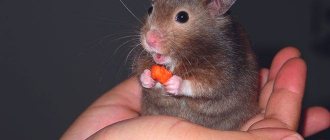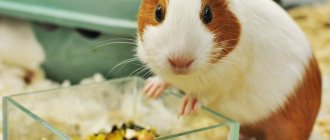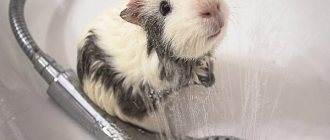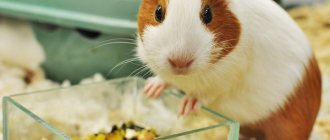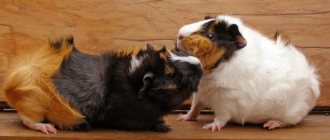Tips for choosing a leash
The anatomy of pigs is not designed for collars. One wrong move can seriously injure your pet. If you leave it free, the animal will slip out. Therefore, harnesses are the best choice for walking. They come in several types:
- In the form of a vest.
- In the form of belts.
- In the form of a figure eight.
Any of them can be purchased at a pet store or sewed yourself. The choice of harness type depends only on your pet’s preferences. The pig should be able to move comfortably and movements should be natural. There is a gap of one finger between the harness and the pet's body, which will prevent squeezing.
Pair selection
Owners are concerned about the possibility of guinea pigs fighting. It is easier to prevent conflict between pets if you deliberately select suitable individuals. It is better to purchase a guinea pig from a trusted breeder. You can get information from him about the character of each animal and its position in the pack.
Important factors when choosing a pet partner:
- gender of animals;
- age;
- status in the pack;
- accommodations.
Young animals develop easier relationships with each other than adults. It is best to have two babies at once, raised together. In this case, the struggle for leadership is easier, or is not required at all. The new resident must be younger than or equal in age to the permanent resident.
The settler who dominated the previous flock will aggressively defend its position in the new place. The owner will not tolerate this and the rodents will begin to conflict. Therefore, it is better to choose a non-ambitious individual for sharing.
Patterns of groups by gender
It is not worth having a different-sex couple if breeding is not planned. Animals experience stress when living together
The female does not like the persistent attention of the male, and his constant refusals. Uncontrolled mating depletes a girl’s body
You can keep a male and female together only if the male is castrated.
Two female guinea pigs converge more easily on the same territory. Fighting for terrain between girls rarely ends in injury. This pair is optimal for a beginning livestock breeder.
Girl guinea pigs get along better than boys
Boys jealously defend their territory. Competition for the lady may break out between them. Two males don't get along well together. Vigilance is always required with them; even friendly rodents can suddenly start a fight. You can make friends between two males only if they do not smell the female.
Relationships in a pack of three or more animals develop according to the same patterns. Among the trio, an unspoken conspiracy of two pigs against the third may arise. Therefore, it is optimal to group animals into colonies of 4-5 individuals.
Anti-stress effect
In our difficult times, many people experience incredible fatigue caused by the need to deal with stress every day. And here everyone finds the necessary outlet for themselves. Some are trying to console themselves by going out with friends, others are rushing to get pets. Guinea pigs evoke many positive emotions.
These are real powerful antidepressants. If such an animal is next to you, you will not be sad
Instead of buying various sedatives, you should pay attention to the prospect of having an animal such as a hamster or guinea pig at home. Pros and cons will help you make your choice
Most often, as a result of this action, a person begins to feel additional meaning in all his daily activities. Having a little furry friend at home greatly helps fight bad moods and various fears.
How to introduce a couple
The acquaintance of the couple is of great importance. There is no need to immediately seat the potential “newlyweds”, since the animals will experience stress with such a sharp acquaintance and may even bite each other.
To prevent this from happening, the following rules must be followed:
First, the pets are introduced on neutral territory. There is no need to put them in a cage; you can give the animals time to get to know each other by simply letting them run around on the floor
This will give the animals plenty of room to maneuver. If one of the pets shows strong aggression towards a potential partner, the dating procedure is stopped and tried again after a few hours. In order for the animals to get used to each other's smell, something from the potential partner's cage is placed in their cages. After two or three days of such “fleeting acquaintances,” the animals can be placed in one cage. An important rule is that the female is placed with the male, but not vice versa.
How to choose a company
You need to be guided by the fact that how rodents get along together. Don’t be nervous that the animals will start competing, because they are easy to make friends with. A large cage, toys for both and separate bowls will help avoid conflicts between rodents. It should be remembered that you cannot place a male with a female, since the inevitable mating will only interfere, especially at a young age, there is a risk of death. Even if the birth is successful, the animal will need rest for about 3-4 months, and the male will not stop, which can cause another pregnancy.
Tama the Cat: Train Station Master
This happened in the early 2000s, when the unprofitable Kishi station in the Japanese city of Kinokawa was almost closed due to unprofitability. Residents, of course, protested, but it is unlikely that their efforts would ultimately be crowned with success. The situation was saved by a local cat named Tama, who loved to bask in the sun near the train station. The station manager noticed how enthusiastically passengers reacted to this couch potato and gave him the official position of caretaker. The cat was given a uniform cap, a badge and a monthly salary in the form of free food.
The duties of the newly minted minister included advertising functions. He greeted passengers, allowed himself to be petted, and was always somewhere on the platform. It must be said that this policy very quickly led to commercial success. Tourists began to come to Kishi station just to look at the railway cat and take pictures with him. From that moment on, there was no further talk about closing the station.
But the unusual cat's career did not end there. In 2008, Tama became a supervisor and was charged with monitoring the performance of professional duties by staff. That same year, the cat was knighted. Another year later, according to the project of the famous designer Eiji Mituku, the railway included in the schedule a train dedicated to the legendary animal. The carriages were painted with views of Tama, the locomotive was decorated with his muzzle, and meowing signaled the opening (closing) of the doors. But this did not become the crown of the cat’s career.
A year later, Tamu was appointed third party of the railway company, entrusted with the post of executive director. By his old age, it was already difficult for him to work every day, and the management allowed the elderly cat to come to work 3 days a week.
Tama died at the ripe old age of 14. But even after this, the career did not end. Posthumously, the cat was elevated to the rank of Eternal Station Master, thus perpetuating his memory. After all, over the years of work, this four-legged employee has brought considerable income to his company. The tourist flow through the station increased to 300 thousand people annually, and the financial indicator amounted to more than 1.1 billion Japanese yen.
The company's management did not want to accept the loss of such a profitable and already promoted advertising brand. Tama was replaced by Nitama (the second Tama). True, later with the third cat there was an overlay. He was found at Okayama Station and offered a position in Kishi. But the owner did not agree to the move. Next came Yontama (the fourth Tama), who had already had to undergo a special training course before taking her place on the platform of the railway station.
And the flow of tourists wanting to take a photo with the legendary heirs of the first Tama still does not dry out.
I like2I don't like
Brief information and history
Its attractive face, calm nature, affectionate disposition and quirky clumsiness make the guinea pig a desirable pet for many children. The small size of the animal allows it to be kept even in a small apartment. Financially, a pig is also more profitable than many other pets, since it eats little, accessories and a house for a rodent are inexpensive. But not everyone decides to purchase a guinea pig, fearing difficulties in caring for it.
The guinea pig is a miniature domesticated member of the pig family. The guinea pig can also be found under another name - “Guinea pig” or “Kevi”. Interestingly, the animal has nothing to do with pigs, wild boars and other representatives of the pig family, as well as with representatives of marine life. It is unlikely that they ever lived in Guinea; it is believed that the birthplace of modern guinea pigs is Peru.
The animal got a funny name in Russia, where it was delivered by sea. And the funny, elongated face resembled newborn piglets. This is where the name “Overseas Pig” came from, which over time transformed into Guinea Pig.
Kevi
Pigs began interacting with people around the 5th century BC. Aboriginal tribes domesticated small, fleshy animals for the purpose of breeding and eating them. Particularly touching individuals were kept as pets. Today, no one eats guinea pigs anymore, and their main purpose is to please their owners.
The lifespan of these small rodents largely depends on the conditions of their detention. On average, they can live from five to eight years. Among guinea pigs you can also find centenarians who lived a long life, fifteen years long. It is extremely difficult to achieve such a result; this is the exception rather than the rule, due to the genetic characteristics of the animal.
Cons of guinea pigs: 7 fly in the ointment
There is nothing worse than disappointment from a pet. A responsible person will continue to care for the animal, but these responsibilities will not bring joy. When such an animal is gone, the owner will feel both shame and relief, but not sadness. An irresponsible person will simply get rid of an inconvenient pet, and it’s good if he finds good hands for it and does not throw it in the trash.
Before getting a guinea pig, you need to learn about the characteristics of these animals, which not everyone will like:
- They make a lot of noise
Guinea pigs not only constantly chew on something, they love to dig into the litter and run around the cage. And they are capable of making a huge number of sounds. Pigs whistle shrilly, squeak, squeal, grumble, chirp, and grind their teeth.
Owners find begging to be a particularly annoying habit. As soon as you slam the refrigerator door or walk past the cage, the pig starts screaming, demanding attention or a treat.
If there are several pets, then they will talk to each other out loud, whistling about something of their own. Talkativeness is the main difference between pigs and other rodents and rabbits.
- They litter and get dirty
Guinea pigs love to dig around the bedding, scattering sawdust, hay, food and their own poop around the cage. Daily housekeeping will be required to keep the room clean. In addition to cleaning around the cage, you need to regularly change the filler.
It is impossible to train a guinea pig to a litter box; it eats and poops constantly. Therefore, when you release an animal for a walk, expect to find traces of its activity everywhere.
- They are afraid of people, but cannot stand loneliness
At the genetic level, the pig suspects that everyone wants to eat it. Despite the fact that these animals are not aggressive, you should not expect friendliness, trust and a desire to communicate from them either. You will have to spend time accustoming the pig to your hands. A pet can be wary of people for a long time, hiding in the house every time they try to pick it up.
We recommend reading: The story of a cat who found a home
However, under no circumstances should you leave the pig alone. They literally waste away and die of boredom. Ideally, you need communication with relatives. That is, in order for the pig to be happy, you must purchase two or more same-sex animals and paw them less, watching the idyll from afar.
- May cause allergies
If one of your family members is allergic to cats or other animals or prone to asthma, you cannot hope that they will not be allergic to a rodent. You can check the reaction to an allergen in guinea pigs in the laboratory, or even more reliably - talk to friends or a breeder for some time with the animals.
Not only the pigs themselves can irritate the respiratory tract, but also dust from sawdust and hay, which must be present in the cage 24 hours a day.
- Expensive veterinary care
These rodents have fragile health and are difficult to treat. Infectious diseases in almost 100% of cases end in death, a draft threatens pneumonia, open sunlight - heat stroke. Most often, pigs get sick from improper feeding: forbidden food causes bloating, diarrhea, and poisoning.
An ordinary veterinarian is unlikely to be able to help: the body of guinea pigs is fundamentally different from that of cats and dogs. Find out in advance whether there is a rodent specialist in your city - a rodentologist (ratologist). If not, contact experienced guinea pig breeders.
Seeing a rodentologist is an expensive pleasure. The most common reason for contacting such a specialist is the pathological growth of teeth in mumps (not only the incisors, but also the chewing teeth located deep in the mouth). If teeth are not properly ground down, they are filed under general anesthesia.
- Primitive behavior
A guinea pig cannot be trained like a dog. You shouldn't expect too much from them at all. The most sociable rodents can respond to their name, but teaching them commands is a hopeless idea. They also do not take any active part in games, preferring to simply run around the room and chew everything they can get their teeth on.
- Coprophagia
Like rabbits, pigs eat their own droppings. Not those solid cylinders that they leave on the litter, but the “primary” liquid, underdigested feces. The pig catches it directly from the anus, curling up into a ball.
For pigs this is absolutely normal and necessary, that’s what Mother Nature came up with. But some people find this feature off-putting.
Poor nutrition
Many companies produce food for guinea pigs, but they are not always of high quality. They can be produced from contaminated grain and various wastes. Rid your pet of cheap grain food. In addition, owners should be aware that the following should be excluded from the guinea pigs' diet: nuts, grains, sugar and honey.
Among the foods we can recommend are the products “Little Van Green Valley” and “Krispy Muesli”. And, of course, succulent food. These include carrots, bell peppers, tomatoes, apples, cucumbers, beets and celery. It must be remembered that the majority of the pig's diet should be hay.
“Humiliating”: star girls expressed their opinion about the show “The Bachelor”
Anyone who makes a correct prediction of the results of the March Madness tournament will receive $1 million
Lots of money, but no sense of style: Ford owners see car design in their own way
Many companies produce it, but experts consider the product to be the best - the branches in it are long, without rot, rodents eat it with pleasure. Another mistake that owners make is related to water. She, like hay, must be in the cage at all times, clean and fresh.
Never give salt rocks or sweet sticks to your pigs. At best, they will refuse them, and at worst, they will eat this sugar-and-honey muesli and get sick. If you want to pamper your pet, treat him to an apple or pumpkin.
How do guinea pigs behave?
These animals are cute and interesting pets, and watching how they behave is a real pleasure. By the behavior of a guinea pig you can understand what mood it is in, how it feels; determine whether she is hungry. If the person who gets a guinea pig already has such animals, he will quickly be able to distinguish their characters.
For example, one pig is calm, another is active, and the third is timid.
Guinea pigs, or cavias, are social and friendly animals by nature. They are not characterized by attacks of aggression and other habits that are seen in other rodents.
They are characterized by poor tolerance to loneliness, a high need for daily communication with the owner and movement around the apartment.
People who get such an animal for the first time note that after a while the animal’s behavior changes. If the owners do not have time to communicate with the pet, the animal will be bored, become lethargic, lose appetite, its skin will begin to itch and its hair will fall out.
To eliminate all complications in the animal’s well-being, he needs to purchase a pair. The second guinea pig may be of the opposite sex. Two females can also get along well together, but whether two males can get along in the same house depends on the breed of pets purchased.
If the animal is not the only pet, this is not a problem. He will easily make friends with the rest of the residents of the house. Pigs have good connections with rabbits, hamsters, dogs, cats and even birds.
Their owners also note that animals quite often lick their owner’s hands
Sometimes this is due to the fact that the hands have a specific smell, and in other cases this action of the animal is a gratitude for the attention received. A guinea pig can express its devotion to him by licking his owner's hands.
Making friends with two pigs is quite easy. By their natural qualities, they are communicative, and living together is not only more convenient, but also more fun. Thanks to active games, they are in motion most of the time, which has a positive effect on their physical fitness and health.
Paired content
This is also a difficult point that needs to be taken into account in a timely manner.
Guinea pigs should only be kept in same-sex pairs. If an animal is kept alone, rest assured that it will soon become ill and die. Guinea pigs are incredibly social rodents. They need communication just like air. Breeding them is quite difficult; the offspring are often born unhealthy. For this reason, you need to put a relative of the same sex in the same pig's cage. It is better to do this soon, as soon as you have a pig, or buy two pets at once.
Accordingly, all expenses double. If a person is already not rich, then it will be difficult for him to allocate funds for the maintenance of his pets.
Cons of Guinea Pigs
These cute animals have negative character traits, but not many of them:
- Complex nature. Guinea pigs rarely show their temper. This can happen due to the fact that the previous owner treated her poorly, offending and causing pain. After this, the animal becomes timid, withdrawn and does not make contact with humans.
- They damage property. The guinea pig is, of course, a pet, but still a rodent. You should not let the animal roam around the apartment without the supervision of the owner. After such walks, you will end up with damaged wallpaper, furniture and wires. Nature will still prevail over the pet.
- Clean your fur coat. This “flaw” only applies to pigs with long hair. The animal is not able to cope with its hair on its own, so it requires human help.
How to choose a breed
All breeds can be divided into 2 types:
Short-haired and long-haired
Shorthair
- Self - these guys are painted in one color. Moreover, the paws and ears are also of a uniform shade.
- Satin - with a soft, glossy skin. The color is usually uniform, but there are also mixtures.
- Bicolor - two colors on the coat
- Tri-color - three different colors have a border and do not mix with each other.
- Dalmatians are white with black spots. The muzzle and paws are usually always black.
- Himalayans - these animals are white, with the exception of black paws and the nose area.
- Agouti is a dark coat with light tips.
- Teddy – They have wavy and short fur.
Longhair
- Sheltie - long hair grows from the muzzle down.
- Peruvian - long hair grows towards the muzzle and falls over the eyes.
- Texel - long curly hair grows from the muzzle.
- Alpaca - long curly hair grows towards the muzzle.
First meeting
If you place two unfamiliar animals in the same dwelling, a ritual of acquaintance and establishment of rank will take place between them. In this ritual, sniffing and trying to jump on each other's backs are standard actions. Guinea pigs chatter their teeth and try to jump on each other. You should not create obstacles to their acquaintance. All that is required from the animal owner is patience.
Establishing a rank often lasts several days, after which the animals behave peacefully.
Due to the fact that pigs also have their own personalities and dislikes, before purchasing a new pet, you need to carefully consider whether it suits your group.
Expert advice: before placing a new animal in a cage with a group, you need to rub the back of its body with the litter that is already in the cage in which you want to place it. As a rule, after this the animals accept the newcomer as one of their own. This method helps when meeting for the first time in a neutral area.
During this period, the cage should be washed and filled with the necessary accessories. It is necessary to make a small rearrangement of the animals' housing. Housing for the group must accommodate a house for each pig. In the first few weeks, food should be scattered throughout the cage to eliminate possible conflicts between pets.
If the breeder sees that rodents are fighting, the following measures must be taken:
- Knock loudly near the cage. An unexpected sharp sound distracts the animals.
- Spray warm water on the animals.
- Try to separate them manually using rough gloves.
- The conflict is over. Now, for some time, the pigs need to be moved to different rooms. And start getting to know each other again.
Based on all of the above, we can conclude:
The male needs to be castrated. This will help dull the animal's protective instincts. The process of sterilization of females is more complicated. It is recommended to purchase pigs while they are still young. For example, take a young animal of the same sex as an adult animal. It is worth raising two animals together from an early age, this way you will eliminate the incompatibility of animals. Guinea pig is a small but strong animal
If the animal is angry, you must handle it carefully so as not to get a scratch. The animal can be aggressive; during a fight, it can bite through the skin of another pig. You should not place an unsterilized male with a female. These animals reproduce quickly.
Breeding
Breeding rosette pigs has its own nuances. The gene that is responsible for the formation of spirals and the rigidity of the cover is dominant. When mating two representatives of the breed, offspring without rosettes may appear if the recessive allele for smooth hair (r) is present in the genotype of both parents.
In addition to the rosette gene, an important role is played by the genetic modifier marked M. If it dominates, then the formation of correct rosettes is suppressed even in the presence of the rosette gene.
In such pigs, instead of normal spirals, the following are formed:
- combs only;
- curls on wool;
- only 2 sockets and one comb.
If the modifier gene is in a recessive state (marked mm), then rosettes of the correct shape are formed. In fact, to breed good pigs, a superficial knowledge of their genetics is not enough. Under the influence of various factors, even purebred animals can produce descendants that are far from perfect.
The rosette pig is mated with a male at the age of 4-10 months, if it weighs more than 700 g. Estrus occurs every 16-20 days. The most favorable time for fertilization is the first 6 hours of sexual heat. It is advisable for the male to make several cages during mating games, then the likelihood of pregnancy will be higher.
The rosette guinea pig carries its young for 63-66 days. There are 3-4 piglets in a litter, less often – up to 6. The more babies in the womb, the shorter the gestation period. The first birth can last 2-3 hours, each subsequent one occurs faster. Rodents are born at intervals of 5-7 minutes.
Caring for rosette pigs cannot be called difficult. Rodents are unpretentious, so they won’t cause much trouble. In response to the care and love of their owner, they will willingly give a lot of positive emotions.
What to look for when purchasing
Before purchasing, you should ask the seller several important questions:
- about whether it is a female or a male;
- about age;
- availability of vaccinations;
- about health status;
- about parents;
- about food.
Girl or boy
If you plan to purchase only one animal, it does not matter whether it is a female or a male. However, remember that guinea pigs are social animals and live in groups in the wild, so it is best if you buy a pair. When planning breeding, a female or male will be required. If there is no such goal, then it is better to purchase two females - they get along well with each other.
Two males can fight for territory and inflict wounds and injuries on each other. This problem can be solved by fencing off 2 zones in the cage with bars. On the one hand, the animals will not be bored and will communicate with each other, on the other hand, clashes will be avoided.
Important! If you are purchasing a guinea pig for a child, the child must be at least 3 years old. From 3 to 6 years old, a child can play with a rodent only in your presence
A child can become a full-fledged and responsible pet owner from the age of 12.
Age
The best age to purchase a rodent is 4–5 weeks. It is not worth purchasing smaller individuals, since they still require the presence of the mother and feeding with milk. It is strictly forbidden to bring babies under 3 weeks into the house. Animals older than 5 weeks will find it more difficult to adapt to a new environment, living conditions and owner.
Behavior
When choosing an animal, preference should be given to active and inquisitive individuals who are not afraid of human approach and hands. It is better to avoid buying lethargic, passive, too timid rodents.
Important! When buying an animal, do not forget to ask the breeder what food it was fed, and take some of it from him so that the transition to a new species is comfortable for the animal.
When purchasing from a pet store or nursery, ask to sit the awake rodent on a counter or table. If at the same time he does not get scared, does not shrink into a ball, then it means he is healthy, not fearful and does not experience stress.
If you take the pig in your hands, and it does not break away, but looks at you with interest, then everything is fine with the animal, and you can safely purchase it.
Did you know? The body of guinea pigs, like humans, cannot produce vitamin C on its own. They need to replenish its reserves with food.
Health status
When you have your eye on the animal you like, you need to evaluate its behavior, and then pick it up and examine it thoroughly.
A healthy pig is characterized by:
- moderate fatness;
- shiny, clean coat, particularly around the anus;
- not liquid stool;
- activity;
- brilliant, lively eyes;
- dry paws;
- smooth, clean teeth;
- clean mucous membranes of the nose, mouth, eyes.
The presence of diseases will be indicated by:
- copious discharge from the eyes and nose;
- increased salivation;
- loose stools;
- heavy, rapid, hoarse breathing;
- bald spots on the body;
- unkempt-looking coat;
- restless or lethargic behavior;
- trembling in the body;
- excessive thirst.
Familiarize yourself with the nutrition and maintenance of guinea pigs at home.
Conditions of detention
Of course, you should not take animals if you see that they are not well-groomed and the cage in which they live is not cleaned. There is a high risk that such rodents have any diseases or are infected with parasites. A responsible breeder or seller will never allow their pets to be kept in unsanitary conditions.
Video: how to choose a guinea pig
Therefore, guinea pigs are an excellent choice for apartment living. They are flexible and friendly. They love to play, learn, and communicate with people. Can tolerate children's hugs and persistence. Guinea pigs do not require special conditions and care.
They require a spacious cage with accessories and toys, periodic cleaning of ears and teeth, trimming of claws and fur (for long-haired dogs). Only those with long hair need rare bathing.
With the right choice of a healthy individual when purchasing and proper care, a pig can live next to a person for up to 5 years. The only disadvantage of keeping a guinea pig is that this rodent is social, so to maximize its comfort you need to get it a friend.
What does skinny eat?
Photo: Skinny pig
Skinnies are herbivores. This means they eat plants. Like their hairy brothers, these pigs will be happy to eat only hay and greens. They are also coprotrophs - they eat their own excrement.
However, you should feed them a daily vitamin C supplement, whether in tablets or liquid. This is because guinea pigs do not produce vitamin C on their own. The young, however, require their mother's milk for the first few days of their lives. If your Skinny has been rejected by her mother, you will have to hand feed her.
Use a teaspoon rather than a syringe because this can cause the little skinnies to choke. You can either use full-fat goat's milk or make formula. It is recommended to use half water and half evaporated milk. After a few days, they can begin to eat like adult skinnies.
The most common food for skinnies is hay. Skinnies are very sensitive animals and their diet consists mainly of vegetables and fruits. The diet should consist of foods rich in vitamin C. This is achieved, for example, by feeding a quarter of a whole pepper per day. Peppers can be red or green. Red bell peppers should not be given to skinnies daily due to their high sugar content, so green bell peppers are an ideal substitute. To increase the amount of vitamin C, two to three leaves of kale are recommended, given to skinny twice a week. In addition, broccoli, basil and mint can be fed to skinnies in a few sprigs on a rotating basis each week.
To increase your supply of vitamins, your diet should include:
- salads;
- cucumbers;
- parsley leaves;
- tomatoes;
- apples;
- pears;
- seedless grapes;
- citrus;
- green bean;
- spinach;
- bananas.
Other foods you can feed your Skinny include hay, oat grass and pellets, which are high in vitamins and a good addition to vegetables and fruits. However, there are some foods that should not be fed to skinnies whole. These are chocolate, meat, potatoes and dairy products.
Guinea pig and dog
You should not risk buying a guinea pig for a house where a hunting dog lives - a four-legged pet poses a great danger to the pig. Even if at first the dog is neutral or even favorably disposed towards the overseas rodent, the pig may involuntarily provoke an attack, awakening the hunting instincts of his “great friend”. If the rodent must share territory with a hunting dog, never leave them unattended in the same room, even if the pig is in a cage. The dog is capable of getting the pig out of the cage, or at least greatly scaring it.
Guinea pigs can get along quite well with dogs of other breeds, and often make friends. The dog must immediately be taught that the guinea pig should be perceived as a member of the family. This is easy to do if the dog is introduced to the pig as a puppy. Of course, the process of taming an older dog to a newbie will take longer. In any case, acquaintance should take place slowly and under the close supervision of the owner. The complete indifference of pets to each other at first glance can be deceptive. Aggression on the part of a dog is possible, for example, due to jealousy, which can end sadly for the pig. Moreover, there are also cases when a rodent can painfully bite an overly active and annoying puppy. Therefore, in cases where the owner of the animals is not entirely sure of their mutual sympathy and friendly relations, it is best to keep pets away from each other. Also, don't forget that a large dog can inadvertently crush a gentle guinea pig if no one is nearby.
How many pigs do you need to be completely happy?
Keeping a guinea pig alone should be considered animal cruelty. A lonely pig moves little, eats more and develops behavioral disorders. Such animals even live significantly less than happy relatives in the group.
If you are not ready to keep two pigs, don’t get one. A lonely animal will never be happy; guinea pigs are too determined to communicate with their own kind. After all, in nature these animals live in colonies.
Even if the pig is “friends” with the owner, with the cat, with the dog, communication with another pig will not replace it. It’s worth watching the animals that live together to understand the difference: they play, groom each other’s fur, sleep in each other’s arms, and chirp.
It’s not too late to add relatives to an adult guinea pig. Some owners don't do this to keep their pet tame and friendly. Or more correctly, painfully dependent on rare human attention. There is no need for selfishness: pigs in a group are much more interesting to watch, and they will remain tame if you devote time to them every day.
Peppermint treat
Ingredients:
- 1 medium overripe banana.
- 2 chicken eggs.
- 3 tbsp. spoons of honey.
- 3 tbsp. tablespoons of liquid coconut oil (can be replaced with sunflower oil in the same amount).
- 1/2 teaspoon mint flavoring.
- 1/2 teaspoon baking powder.
- A quarter cup of carob (roasted carob powder). A small amount of cocoa can be substituted, but this is not recommended for animals. Therefore, try to find an original product.
- Oat flour.
Cooking procedure.
1. Mash the banana in a bowl.
2. Beat eggs into the resulting mass, add honey, baking powder, cinnamon and coconut (sunflower) oil.
3. Add oatmeal to the mixture to form a firm but slightly moist dough.
4. Divide the resulting volume into 2 equal parts.
5. Pour 1/4 cup of carob powder into one half, and add the same amount of flour to the second half. A hard lump should form that does not stick to your hands.
6. Roll out 2 rectangles, 9-10 mm thick.
7. Place the layers of dough on top of each other and roll along the long side. Wrap the resulting sausage in plastic wrap and put it in the refrigerator overnight.
8. Preheat the oven to 180 degrees.
9. Cover a baking sheet with parchment paper.
10. Remove the film and cut into 3-3.5 cm rounds.
11. Place on a baking sheet. During cooking, portions of dough will not increase in volume, so you can place them close to each other.
12. Bake for 10-15 minutes.
If you want to please your pet with a crunchier treat, cut the rolls into thin slices (about 1 cm), and after cooking, additionally dry them in a warm oven or even in a non-stick frying pan.
The finished product is stored for a long time in a dry place. So, by baking peppermint rolls once, you can treat your four-legged pupil with them for a long time.
Bon appetit to your dog!
I like it I don't like it
Reproduction
The female is ready to reproduce offspring already at the 5th month from birth, the male guinea pig at the 6th. But breeders recommend that the first matings be carried out no earlier than the pets are 10 months old. Animals of the same breed and age that are not related to each other are chosen as parents. Obese individuals are not suitable for reproduction.
Females are ready to breed every two weeks or month for two days. 10 days before the onset of estrus, vitamin E is added to the female’s diet. It is best if the female becomes pregnant no later than November, then she will have time to feed her offspring before the onset of molting. Molting is a difficult process for an animal; in combination with feeding, it puts a lot of stress on the female’s body.
It is easy to determine that a female is ready to mate. She lifts the back of her body, spreading her paws to the side.
Fertilization occurred if the female did not start another estrus within 20 days. Then she is transplanted into a separate cage.
The female's pregnancy lasts 10 weeks. At this time, you don’t need to carry her in your arms, often take her out of the cage and fiddle with her unnecessarily. Excess stress can lead to miscarriage.
Mother pigs can develop toxicosis. It occurs in the period before and immediately after childbirth. At this time, females experience muscle cramps, loss of appetite, deterioration of coat condition, and drooling. Toxicosis can be avoided if you make the right diet, add vitamins and prevent stress. Toxicosis also occurs due to pregnancy with many children. Females usually give birth to 3 to 5 piglets.
Guinea pigs usually give birth as usual and last about half an hour. Newborns can see and hear and also have incisors. 2 days after birth, they can already eat regular food. And when they are a month old, they can be moved into a cage for further independent life.
Before getting a guinea pig, study information about these cute rodents. Caring for the animals will be easy for novice breeders. However, the owner is responsible for the health and well-being of his pet. After all, only a healthy animal will be cheerful and playful and bring joy to its owner.
Drinking fountain
Such a device can serve not only to quench the thirst of animals, but also become an original accent in the home interior. The design consists of a water bowl, a filter, a diffuser and a drinking bowl located at the top. Additionally, it is equipped with a decorative sprinkler, especially popular with native breeds (Maine Coons, Kuril Bobtails, Siberian cats).
Continuous circulation of liquid is ensured by a mini-pump powered by a USB cable. More advanced models may contain backlighting and an indication of the level of remaining water in the tank.
Cost – 2400 rub.
In favor of the chinchilla
Chinchillas live on average from six to ten years. Very active and friendly, they love a lot of space. They are often allowed to walk around the house. They are housed in large metal cages with a plastic tray, often homemade. The disadvantages include a nocturnal lifestyle, it is at this time that they are most active. They sleep during the day or have lethargic behavior. For this reason, the chinchilla is not suitable for everyone, since at night it is quite noisy and interferes with sleep.
Many animals do not like being alone and need a partner. Chinchillas are not like that; they can be kept alone. Although she will not refuse a partner, since she is very sociable. It will quickly become a good companion and friend for children. In general, there are advantages to supporting one person and an entire family. The behavior is very interesting to observe from the outside, especially when they play together. The male and female during the mating season is a separate issue; they constantly chase each other around the cage or sit next to each other and watch each other.
Chinchillas are distinguished by their intelligence and ingenuity; they quickly understand what’s what and how to behave. Easy to toilet train. Some individuals are very cunning; when they need something from a person, they sit in the corner and look at him. This behavior quickly bears fruit.
You need to feed your chinchilla a variety of foods: nuts, vegetables and fruits, special food, hay, and even food from our table. The animal must have access to fresh water. Since they love to swim, a special bathing suit is left in the cage once a day for an hour.
There are several main advantages of keeping a chinchilla at home:
- Easy care;
- Rare diseases;
- No unpleasant odor;
- They make contact easily with people and animals;
- Easily tamed;
- Are subject to training;
- They never bite;
- Beautiful appearance;
- They have an interesting character and are able to quickly cheer up;
- They live 6–10 years, some individuals live up to 20.
The last fact can be attributed to pros and cons at the same time. Not everyone wants to take responsibility for an animal for a third of its life.
There is one interesting character trait: they are able to be offended and show it. If you don’t take him for a usual walk or entrust the care to other people, you can see that the pet is offended. Cheerfulness disappears, often even stops taking food from hands. But it’s enough to sit next to you and apologize, and she immediately understands everything and becomes active and friendly again.

